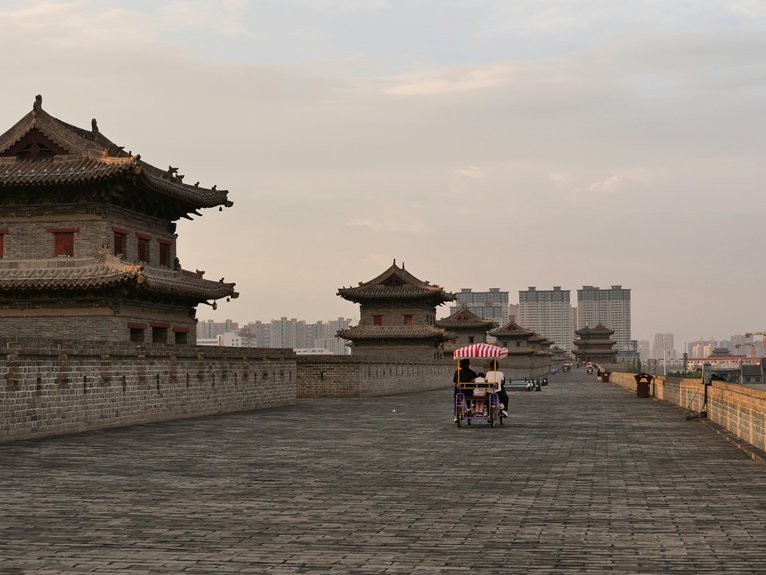Exploring Venetian Wall Tours in Nicosia lets you uncover the city’s historic fortifications, built by Venetian engineers in the 16th century to counter advancing artillery. These walls feature circular bastions, grand gates named after noble families, and unique designs blending medieval and Venetian engineering. The tours highlight the walls’ strategic layout, their role in Mediterranean defense networks, and their eventual breach by the Ottomans in 1570. You’ll also discover nearby landmarks like the Famagusta Gate and Shacolas Tower, offering insights into Nicosia’s rich history. Continue your journey to learn more about these iconic walls and their lasting legacy.
Key Takeaways
- The tours explore the 16th-century Venetian Walls, highlighting their historical significance, architectural design, and role in Nicosia’s defense.
- They cover key landmarks like the Famagusta Gate, now a cultural center, and the Liberty Monument, symbolizing Cyprus’s independence.
- Visitors learn about the walls’ strategic design, including circular bastions and unlined upper sections for better defense against artillery.
- The 75-minute walking tour includes 21 stops, offering insights into the walls’ military history and their eventual breach by the Ottomans in 1570.
- The tour incorporates storytelling and VoiceMap technology to provide a self-paced, immersive experience of Nicosia’s historic fortifications and surrounding monuments.
Historical Background of the Venetian Walls
The Venetian Walls of Nicosia originated in the Middle Ages but were entirely rebuilt by the Republic of Venice in the mid-16th century as part of a broader effort to fortify their territories. This reconstruction was driven by the growing threat of Ottoman expansion, particularly after the 1565 Siege of Malta. Venetian engineers, including Giulio Savorgnan and Francesco Barbaro, designed the new walls, demolishing earlier Frankish structures to create a more modern defense system. The walls were part of a network of Venetian fortifications across their territories, aimed at protecting the city and its inhabitants from advancing Ottoman forces and artillery. However, despite these efforts, the walls were breached by the Ottomans in 1570 during the Fourth Ottoman-Venetian War, leading to the capture of Nicosia and a devastating massacre. Today, guided tours of the Venetian walls in Nicosia, Cyprus, offer a glimpse into this rich and complex history, allowing visitors to explore the remnants of a bygone era and understand their historical significance.
Architectural Features and Design
Circular bastions with arrow-shaped designs define the Venetian Walls’ architectural landscape, blending medieval elements with Venetian engineering innovations. These structures, built in the 16th century, showcase a mix of robust fortifications and strategic design. The walls are 5 kilometers long, with three grand gates-Paphos, Famagusta, and Kyrenia-positioned to control access while enhancing defensive capabilities. Each bastion is named after noble families who contributed to their construction, adding a historical layer to their functionality. The upper half of the walls was intentionally left unlined, a deliberate design choice to better absorb cannon fire. This innovative approach reflects theVenetians’ advanced engineering skills, merging practicality with creativity. The circular layout of the walls, combined with strategically placed bastions, creates a formidable defensive system that has withstood the test of time, offering a glimpse into Nicosia’s rich history. Walking along the walls, you can appreciate the intricate balance between form and function that defines their architectural identity.
Military and Strategic Importance
Defense was the unsung hero of 16th-century Nicosia, as the Venetian Walls stood as a monument to the city’s strategic ingenuity. Built in the early 1500s to counter advancing artillery technology, the walls were engineered with circular bastions and arrow-shaped designs to enhance defense against siege warfare. These features allowed for better coverage of the battlefield and improved resistance to cannon fire. Designed by skilled Venetian engineers like Giulio Savorgnan, the walls were part of a broader network of fortifications across the Mediterranean, reflecting Venice’s imperial ambitions. Unlike the earlier Frankish walls, the Venetian Walls were constructed on a smaller, more efficient scale, prioritizing defense over expansive city enclosure. However, despite their advanced design, the walls were breached by the Ottomans during the Fourth Ottoman-Venetian War, leading to Nicosia’s fall. This outcome underscored both the walls’ strategic significance and the limits of their defenses in the face of relentless assault.
Nearby Monuments and Landmarks
Walking around the Venetian Walls, you’ll discover a wealth of historical and cultural landmarks that complement their defensive grandeur. The Liberty Monument, a striking symbol of Cyprus’s independence, stands nearby, offering a poignant reminder of the island’s modern history. Close by, the Shacolas Tower Museum and Observatory provides a fascinating perspective, where panoramic views of the city meld with historical exhibits. The Famagusta Gate, an integral part of the Venetian Walls, now thrives as a vibrant cultural center and event space, hosting exhibitions, performances, and workshops. Beneath the walls, the former moat has been transformed into a dynamic public area featuring sports fields, lush gardens, and an impressive open-air sculpture exhibition. Finally, the Archbishop’s Palace, a monumental structure with its own historical significance, lies at the edge of the walled city, marking a key endpoint for your exploration. Together, these landmarks create a rich tapestry of history, culture, and urban evolution.
Touring the Walls: Practical Information
This 75-minute walking tour traces the historic Venetian Walls, starting at the fortifications and concluding at the Archbishop’s Palace, spanning 0.9 miles of Nicosia’s historic landscape. Led by Katerina Solomidou’s narration, the tour features 21 stops, each offering a detailed look into the city’s past. The full tour is available for $6.99 via Stripe, with a free preview mode that lets you explore the first three stops. Using VoiceMap technology, you can navigate the route at your own pace, receiving insightful commentary as you go. Along the way, you’ll encounter landmarks that reflect Nicosia’s architectural evolution under Venetian, Frankish, Ottoman, and British rule. The tour provides a seamless blend of history and exploration, ensuring a deep understanding of the city’s fortifications and their significance. Be sure to wear comfortable shoes, as you’ll be walking on uneven terrain, and plan your visit during cooler parts of the day for a more enjoyable experience.
Cultural Significance and Modern Usage
The Venetian Walls stand as a legacy of Nicosia’s storied past, embodying the city’s strategic importance and cultural richness. These ancient fortifications are more than just a historical relic; they’re a living part of the city’s identity. As you explore the walls, you’ll uncover how they bridge the past and present:
- The moat’s transformation into vibrant public spaces like sports fields and gardens highlights the city’s adaptive spirit, turning a former defense feature into a community hub.
- Guided tours reveal the walls’ intricate history, offering panoramic views that connect visitors to the city’s evolution over centuries.
- As a cultural symbol, the walls link Nicosia’s medieval heritage to its modern identity, embodying resilience and tradition.
Today, they seamlessly integrate historical preservation with urban life, showing how the past can inspire the present.
Frequently Asked Questions
Are the Venetian Walls Accessible to People With Mobility Issues?
The Venetian walls in Nicosia, with their ancient stone structures and uneven terrain, may present challenges for those with mobility issues. While certain areas like flat viewpoints might be accessible, others, such as stairways or narrow passages, could be difficult. Tour operators might offer assistance or alternative routes, but it’s advisable to check ahead with them for specific accommodations. Planning in advance is essential to assure a smooth experience.
Can I Take Photos Inside the Bastions for Personal Use?
You step into the bastions, surrounded by centuries-old stone walls that whisper tales of Nicosia’s rich history. Yes, you can take photos inside the bastions for personal use, capturing the intricate architecture and historical details. Imagine framing the grand archways, the weathered stone carvings, and the sweeping views of the city. Just make sure you’re not violating any posted restrictions or disrupting guided tours. It’s a great way to preserve memories of your exploration.
Are Guided Tours Available in Multiple Languages?
Yes, guided tours of the Venetian fortifications are available in multiple languages, catering to diverse visitors. English tours are typically standard, but options like French, German, or even Greek can be arranged upon request.(Guided tours are available in multiple languages to accommodate international visitors. English is commonly offered, while French, German, or Greek tours can be arranged in advance. This guarantees an all-encompassing and immersive experience for all participants.)
How Long Does a Typical Venetian Wall Tour Last?
A typical Venetian Wall Tour lasts about 1 to 2 hours, depending on the route and depth of exploration. You’ll cover key sections of the 16th-century fortifications, such as the Famagusta Gate and the bastions. Guides provide insights into the walls’ history, construction, and role in Nicosia’s defense. Tours may also touch on the city’s medieval past and its significance as a capital. Some tours offer flexible pacing, allowing for more detailed stops or quicker overviews.
Is It Possible to Explore the Venetian Walls at Night?
“The night is dark, but the walls tell their stories best under the stars.” Exploring Nicosia’s Venetian walls at night is possible, though options are limited. Guided tours may not typically run after dark, but you can venture on your own if the gates are open. Bring a flashlight or use your phone’s light to navigate and admire the historic fortifications. The quiet evening hours offer a unique ambiance, immersing you in centuries of history. Plan ahead if joining a tour.
Conclusion
As you walk along Nicosia’s Venetian walls, you step into a tapestry woven with centuries of history, where every stone whispers tales of resilience. Beyond their imposing structure, these fortifications reveal a city’s heartbeat, blending strategic brilliance with artistic flair. Today, they stand as silent guardians, bridging the past and present, their enduring charm enthralling all who wander their ancient paths, making them a legacy to time’s passage and human ingenuity.

Meet Natalie, who has lived on Cyprus for the last 10 years. She loves exploring the beautiful nature of the island, like quiet forests and untouched beaches. Natalie has lots of cool experiences to share. Join her as she talks about her adventures in Cyprus.

